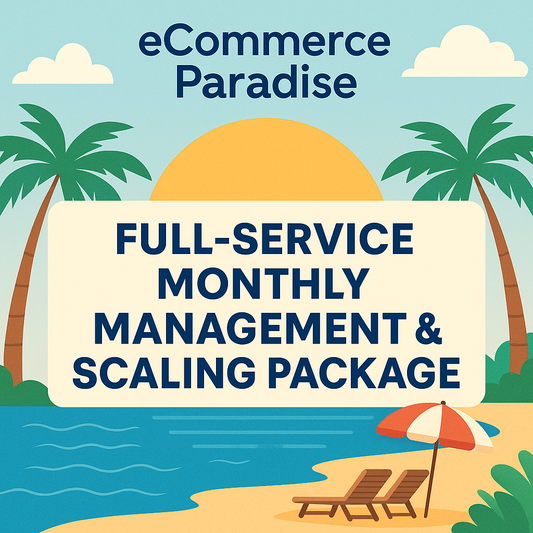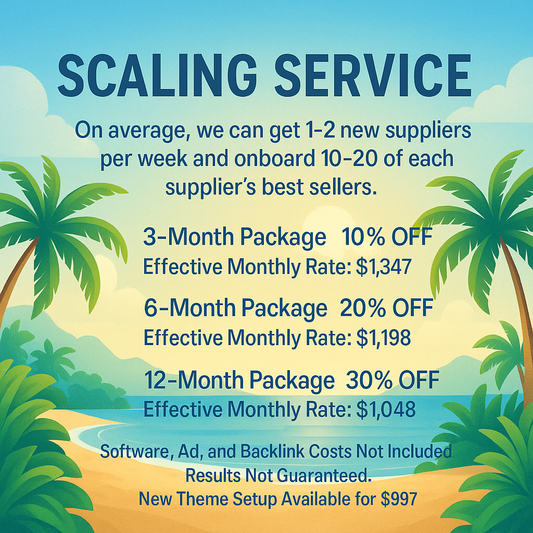
Unlocking Success: The Power of Customer Journey Mapping in High-Ticket E-commerce
Welcome to Ecommerce Paradise! Today, we're delving into an essential topic for anyone involved in high-ticket e-commerce: customer journey mapping. As a founder who’s seen the ups and downs of the dropshipping world, I can tell you this tool is a game changer for understanding your customers. Knowing how to chart their path not only helps in maximizing sales but also enhances the overall customer experience. Let’s explore how to use customer journey mapping effectively in high-ticket drop shipping.
What is Customer Journey Mapping?
Customer journey mapping is all about understanding the process your customers go through from first hearing about your store to completing the purchase—and even beyond that. This visual representation helps you identify key touchpoints where customers interact with your brand, which can be crucial in high-ticket e-commerce where the purchase decision often requires more consideration.
Why is Customer Journey Mapping Essential?
In high-ticket e-commerce, the stakes are higher. Customers typically invest more time and effort in researching before making a significant purchase. Here are a few reasons why customer journey mapping is vital:
- Enhanced Understanding: It allows you to gain insights into customer behavior and preferences.
- Improved Marketing Strategies: Helps refine your marketing approaches to better cater to potential customers.
- Increased Conversion Rates: Optimizes the sales funnel to boost conversions in high-ticket dropshipping.
- Customer Retention: Enhances post-purchase engagement, which is critical for repeat business.
The Stages of the Customer Journey
To effectively map the customer journey, you need to understand the key stages that buyers go through:
Awareness
This is the stage where potential customers first learn about your brand. This could be through social media ads, blog articles, or word-of-mouth. For high-ticket e-commerce, it’s essential to establish your brand as trustworthy from the get-go. Consistent branding and engaging content can play a significant role in converting awareness into interest.
Consideration
Once potential customers are aware of your existence, they start considering their options. They’ll likely compare your offerings with competing products. Here, providing ample information about your products, including features, benefits, and customer testimonials, will help sway their decision in your favor.
Decision
During this stage, customers are on the verge of making a purchase. It's crucial to minimize friction in the buying process. Ensure that your website is user-friendly, your checkout process is seamless, and you offer various payment options. This is particularly important in high-ticket dropshipping, where a smooth, reassuring experience can close the deal.
Post-Purchase
After the sale is made, the journey isn’t over. This stage is about nurturing the customer relationship, encouraging repeat purchases, and soliciting feedback. Sending follow-up emails, providing excellent customer service, and creating loyalty programs are just a few strategies to keep your customers engaged.
Tools and Techniques for Customer Journey Mapping
Now that we understand the stages, it’s vital to know how to map out the journey effectively. Here are several tools and techniques that can assist with customer journey mapping in high-ticket e-commerce:
1. Customer Persona Development
Begin by creating detailed customer personas. Analyze demographic factors, shopping behaviors, and pain points. This will form the foundation of your customer journey map, helping you tailor communication and marketing strategies specific to your target audience.
2. Data Collection
Utilize analytics tools like Google Analytics, heatmaps, and feedback surveys to gather data about customer interactions. Look at where customers drop off in the sales funnel to identify and address potential pain points in the buying process associated with high-ticket e-commerce.
3. Visual Mapping Tools
Consider using visual mapping tools like Lucidchart, Smaply, or even simple flowcharts to represent the customer journey. Visual aids can help you spot gaps and opportunities for improvement more effectively than just written notes.
4. Continuous Improvement
Implement a feedback loop into your mapping process. Gather insights from real customers frequently and make adjustments to your journey map based on their experiences. This positions your high-ticket dropshipping business to respond to changing customer expectations effectively.
Implementing Your Customer Journey Map
Creating a customer journey map is just the beginning. The real challenge lies in implementing changes based on your findings. Here’s how to effectively use your map to improve your high-ticket ecommerce operations:
Align Your Teams
Engage various teams within your organization—marketing, sales, and customer service—all need to work in concert with your mapped journey. Make sure everyone understands how their role impacts the customer experience. This alignment ensures a cohesive journey for the customer.
Optimize Marketing Efforts
Use the insights from your customer journey mapping to refine your marketing strategies. For example, if data shows that customers are particularly influenced during the consideration stage, focus on providing comprehensive product comparisons, expert reviews, and engaging video content that highlights your offerings in high-ticket dropshipping.
Test and Adjust
Utilizing A/B testing for different elements can provide invaluable insights. Test different copy, layouts, and even product presentations to see how changes impact customer feedback and behavior. The goal is to continually refine based on data-driven decisions.
Common Mistakes in Customer Journey Mapping
While we’re excited about the prospects of journey mapping, there are common pitfalls to avoid:
Neglecting Customer Feedback
Your customers' insights are crucial. Ignoring this feedback may lead to decisions based on assumptions rather than real-world behaviors and preferences.
Overcomplicating the Journey
Simplicity is key. An overly complicated journey map can confuse team members and dilute focus. Ensure it’s straightforward and easy to follow.
Sticking to an Unchanging Map
The customer journey is dynamic. Trends change, and so do customer needs and preferences. Your map must evolve to remain relevant. Regularly review and adjust based on current customer behavior.
Real-Life Success Stories
Examples illustrate the efficacy of customer journey mapping in the e-commerce space. Brands that do this well often see better engagement and increased loyalty. For instance, companies that specialize in high-ticket items, such as luxury goods or bespoke services, often leverage customer testimonials and user-generated content at the consideration stage.
These elements build trust and provide authentic insights into the buying experience, ultimately leading to higher conversion rates.
Your Path to High-Ticket E-commerce Success
Customer journey mapping is a powerful tool for anyone in the high-ticket e-commerce business. With the right approach, you can transform customer experiences into a seamless journey that not only promotes sales but fosters loyalty and trust. As you implement your customer journey map, remember, the emphasis should always be on the customer. Analyze, adjust, and optimize engagement strategies, leveraging data to drive your high-ticket dropshipping business to new heights.
At Ecommerce Paradise, we are committed to your success. Dive deep into your customer journey today and unlock new pathways to profitability. Happy mapping!


















